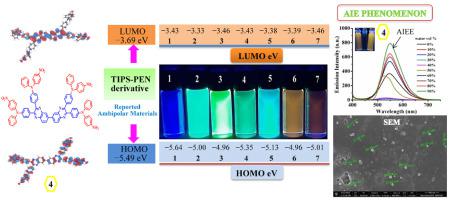Journal of Luminescence ( IF 3.3 ) Pub Date : 2022-09-24 , DOI: 10.1016/j.jlumin.2022.119350 Suraj S. Mahadik , Dinesh R. Garud , Mohammed K. Ghadiyali , Sajeev Chacko , Rajesh M. Kamble

|
A series of six novel donor‒acceptor‒acceptor‒donor (DAAD) based biquinoxaline amine derivatives 2–7 were obtained by employing palladium catalyzed Buchwald‒Hartwig coupling amination reaction. The synthesized compounds were characterized by spectroscopic and electrochemical techniques. The characteristic absorption spectra of dyes 2–7 display intramolecular charge transfer (ICT) transitions in the range of 415–461 nm. Dyes 2–7 show positive solvatochromism in emission and emit in blue−Orange region with emission maxima 492–598 nm in various solvents and neat solid film. Herein, dyes 2, 3 and 4 which possess intense emission in solid state were further studied for aggregation‒induced emission (AIE) effect in THF–water system due to the formation of nanoparticles, as confirmed by FEG‒SEM technique. The HOMO and LUMO energy levels for compounds 2–7 were measured by cyclic voltammetry (CV) and are found in the range of −4.96 to −5.35 eV and −3.33 to −3.46 eV which further correlated by density functional theory calculations. On the basis of comparable HOMO and LUMO energy levels to reported ambipolar materials, efficient solid state emission with good AIE and AIEE properties of the synthesized dyes signify their potential to be used as solid state emitters and ambipolar materials in opto−electronics.


















































 京公网安备 11010802027423号
京公网安备 11010802027423号